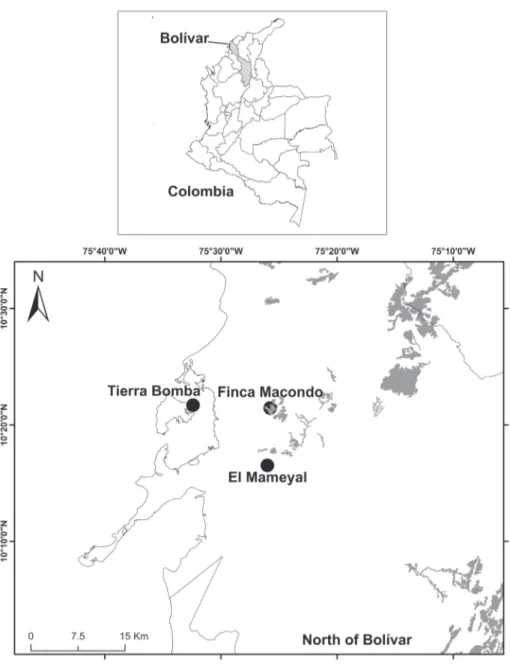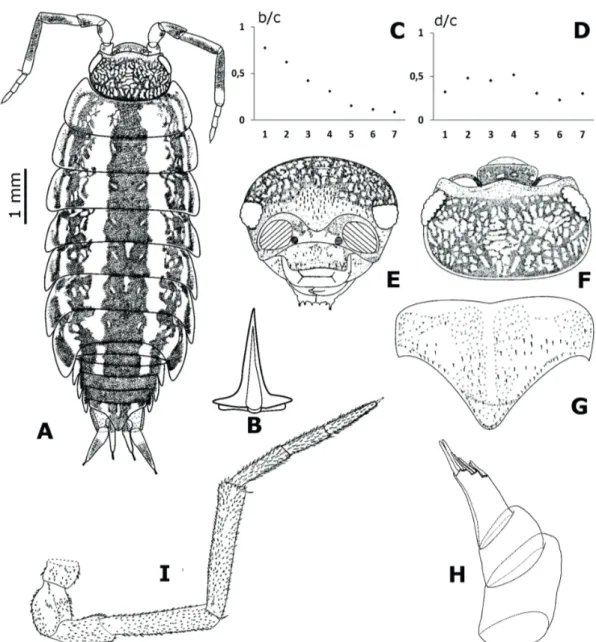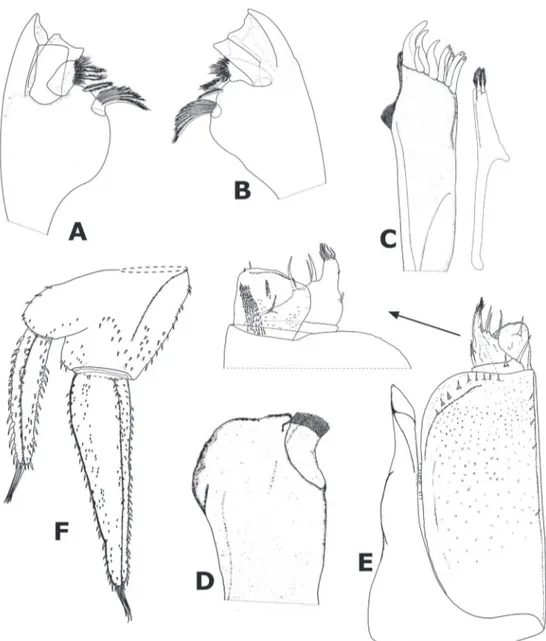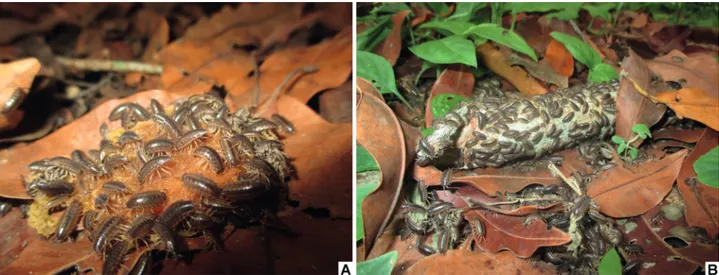THE JOURNAL OF THE BRAZILIAN CRUSTACEAN SOCIETY
e-ISSN 2358-2936
www.scielo.br/nau www.crustacea.org.br
CORRESPONDING AUTHOR Carlos Mario López-Orozco clopezo1@unicartagena.edu.co
SUBMITTED 3 November 2016 ACCEPTED 8 March 2017 PUBLISHED 25 May 2017
DOI 10.1590/2358-2936e2017014 CORRESPONDING AUTHOR
A new species and fi rst record of
Pulmoniscus
Leistikow, 2001 (Isopoda,
Oniscidea, Philosciidae) from Colombia
Carlos Mario López-Orozco
1, Yesenia Margarita Carpio-Díaz
1,
Gabriel R. Navas S.
1and Ivanklin Soares Campos-Filho
21Grupo de Investigación Hidrobiología, Universidad de Cartagena, Programa de Biología,
Campus San Pablo, Cartagena de Indias, Colombia.
CML-OE-mail: clopezo1@unicartagena.edu.coORCID ID orcid.org/0000-0002-3251-7739 YMC-DE-mail: ycarpiod@unicartagena.edu.coORCID IDorcid.org/0000-0001-5116-9736 GRNSE-mail: gnavass@unicartagena.edu.coORCID IDorcid.org/0000-0001-9554-6345
2Programa de Pós-Graduação em Recursos Naturais, Universidade Federal de Campina
Grande, Campina Grande, Paraíba, Brazil.
ISC-FE-mail: ivanklin.fi lho@gmail.comORCID IDorcid.org/0000-0001-6139-8241
ZOOBANKhtt p://zoobank.org/urn:lsid:zoobank.org:pub:2273A11D-AC31-4831-9A3B-4639DBD39C4A
ABSTRACT
A new species of Pulmoniscus Leistikow, 2001 from Department of Bolívar, Colombia, is described. It constitutes the fi rst record of the genus for the country and for the continental portion of the Neotropics. Pulmoniscus turbanaensis n. sp. is distinguished by the male pereopod 7 ischium with concave sternal margin and the shape of the male pleopod 1. In addition, ecological remarks and a distribution map are provided.
KEY WORDS
Crustacea, Terrestrial isopods, Bolívar, Tropical Dry Forest, Neotropical.
INTRODUCTION
López-Orozco et al. New species and first record of Pulmoniscus
The monotypic genus Pulmoniscus Leistikow, 2001 (Philosciidae) comprises Pulmoniscus insularuminfraventum (Vandel, 1952) from Gran Roque (Winward Islands), Cerros Orientales, Venezuela. The genus is mainly defined by the cephalon without lateral lobes, outer endite of maxillula with crown-shaped and 3-tiped apex teeth on outer set, pleopod exopods with monospiracular covered lungs (Leistikow, 2001).
The present work describes a new species of Pulmoniscus, constituting the first record of the genus in Colombia. In addition, ecological remarks and a distribution map are provided.
MATERIAL AND METHODS
Specimens were stored in 75% ethanol and identifications were based on morphological characters. The appendages (antennulae, antennae, buccal pieces, pereopods and pleopods) were prepared in glycerin. The images were obtained with Axio Lab. A1 microscope and SteREO Discovery.V12 ZEISS stereomicroscope with adapted camera Axiocam ERc 5s. The final illustrations were prepared using the software GIMP with the methods proposed by Coleman (2006) and Montesanto (2015; 2016). The coordinates of the noduli laterales were obtained and figured as in Vandel (1962).
Abbreviations
CUDC-CRU: Colección de Crustáceos del Programa de Biología de la Universidad de Cartagena, Cartagena de Indias, Colombia.
ICN-CI: Colección de Crustáceos Isópodos del Instituto de Ciencias Naturales, Universidad Nacional de Colombia, Bogotá, Colombia.
Study Area
The three studied localities are placed at the northern Department of Bolívar, western portion of the Colombian Caribbean (Fig. 1). These localities belong to the Tropical Dry Forest (TDF) ecosystems, characterized by high levels of endemism and beta-diversity. TDF is currently one of the most endangered ecosystems in the world (García et al., 2014). There are
several factors that have caused the fragmentation of this ecosystem. The high level of human establishment, the intense transformation resulted by livestock farming, thinning wood, and burning for the establishment of crops sowing are among the responsible factors for this fragmentation (Escobar, 1997; Rangel-Ch. et al., 1997). The Macondo estate, Turbaco is part of one remaining TDF area. It is located at 100 m from the Botanical Garden Guillermo Piñeres, at an altitude of 130 m. The average annual temperature and precipitation are 28ºC and 900–1,200 mm, respectively. This region is characterized by having marked dry, rainy, and transition seasons, with annual humidity level of approximately 70% (Alcaldía de Turbaco-Bolívar, 2012). The vegetative cover is composed by fruit and ornamental species such as meddler (Manilkara sapota), mango (Mangifera indica), bamboo (Bambusa vulgaris), and sapodilla tree (Pouteria sapota); and by native species such as ceiba tree (Ceiba pentandra), purple oak (Tabebuia rosea), and mata ratón (Gliricidia sepium).
The Mameyal is located at the rural area of Turbana municipality. It is a vegetation fragment that has been preserved for several years. This region shows climate characteristics similar to Macondo estate. The Mameyal is characterized by the presence of mamey fruit (Mammea americana), Mangifera indica, and Manilkara sapota. The dense canopy hinders the passage of sunlight to the ground, preventing the establishment of a structured understory. Those fruit trees are part of the diet of the red howler monkey Alouatta seniculus (Linnaeus, 1766) (Ratiarson and Forget, 2011).
SYSTEMATICS
Philosciidae Kinahan, 1857
Pulmoniscus Leistikow, 2001
Type species. Balloniscus insularuminfraventum Vandel, 1952 by monotypy.
Diagnosis. Leistikow (2001).
Pulmoniscus turbanaensisLópez-Orozco,
Carpio-Díaz & Campos-Filho n. sp.
(Figs. 1–5)
Type material.Holotype: 1 ♂ (CUDC-CRU 12), El Mameyal, Turbana, Bolívar, Colombia, 10°16’31.32”N 75°26’0.25”W, 23.X.2015, leg. Keiner Meza-T.
Paratypes: 1 ♂ (CUDC-CRU 13), 1 ♀ (CUDC-CRU
López-Orozco et al. New species and first record of Pulmoniscus
Figure 2. Pulmoniscus turbanaensis n. sp. ♀ Paratype (CUDC-CRU 14): A. Dorsal habitus; B. Dorsal scale-seta, C. b/c noduli laterales coordinates; D. d/c noduli laterales coordinates; E. Cephalon, frontal view; F. Cephalon, dorsal view; G. Telson; H. Antenna; I. Antennula.
Description. Maximumbody measurements: ♂
(holotype), 8.5 mm length, 3 mm width; ♀ 6.9 mm length, 2.8 mm width. Body outline as in Fig.2A. Color light to dark brown; antennal peduncle with first, second and distal portion of fifth article and flagellum unpigmented; cephalon with irregular unpigmented spots; pereon with dark lines on median and paramedian portions; epimera with one distinct unpigmented row, outer margins unpigmented; pleon strongly pigmented, pleonites 1–3 with two unpigmented spots; telson strongly pigmented, two unpigmented spots on paramedian region, one thin unpigmented spot on median portion; uropods weakly pigmented (Fig.2A).
Figure 3. Pulmoniscus turbanaensis n. sp. ♀ Paratype (CUDC-CRU 14): A. Left mandible; B. Right mandible; C. Maxillula; D. Maxilla; E. Maxilliped; F. Uropod.
with molar penicil dichotomized bearing ten branches, left with 2+1 penicils, right mandible with 1+1 penicils. Maxillula (Fig.3C) inner endite with distal margin rounded bearing two hairy penicils; outer endite of 4 teeth stout plus 5 teeth cleft at apex, three of them with apex crown-shaped. Maxilla (Fig.3D) outer lobe more than twice as wide as inner lobe, distal margin rounded, covered with setae; inner lobe bearing thick setae. Maxilliped (Fig.3E) base rectangular bearing sparse setae; palp with two setae distinct in length on proximal article; endite sub-quadrangular, medial seta surpassing distal margin, distal margin straight with one small seta. Uropod (Fig.3F) protopod and exopod grooved on lateral margin, exopod twice as long as endopod, endopod inserted proximally. Pereopods 1–7
slightly strong; pereopod 1 carpus with longitudinal grooming brush; dactylus of two claws, inner claw not surpassing outer claw, ungual seta and dactylar organ simple not surpassing outer claw. Pleopod exopods with monospiracular pleopodal lungs, spiraculum inserted on one third of length of outer margin, perispiracular area covered with concentric cuticular wrinkles.
López-Orozco et al. New species and first record of Pulmoniscus
Figure 4. Pulmoniscus turbanaensis n. sp. ♂ Paratype (CUDC-CRU 13): A. Pereopod 1; B. Pereopod 7; C. Pleopod 1; D. Pleopod 2; E. Pleopod 3 exopod; F. Pleopod 4 exopod; G. Pleopod 5 exopod.
with two lobes delimiting spermatic channels, one lobe directed outwards and other directed inwards, inner distal margin bearing small setae at apex. Pleopod 2 (Fig.4D) exopod triangular, outer margin almost straight bearing several setae; endopod slightly longer than exopod. Pleopods 3–5 exopods as in Fig.4E–G, respectively.
Etymology. The new species is named after one of the localities where the specimens were colleted: Turbana.
Remarks. Vandel (1952) described the new species Balloniscus insularuminfraventum from Windward
Figure 5. Pulmoniscus turbanaensis n. sp., Mameyal, Turbana. A. Specimens feeding on Manilkara sapota fruits; B. Specimens under piece of trees of Mammea americana, Mangifera indica and Manilkara sapota.
characteristics, dorsal tricorn-setae with broad basis, and male pereopod 7 ischium with more than 5 setae on the lateral margin (Leistikow, 2001).
The pleopodal lungs are one of the most important morphological characteristics related to the terrestrialization process of Oniscidea (Ferrara et al., 1994; Leistikow, 2001). This structure evolved several times within many taxa of the suborder (see Ferrara et al., 1990; Paoli et al., 2002; Leistikow, 2001; Schmidt, 2002, 2003; Cardoso et al., 2016). Regarding the family Philosciidae, the pleopodal lungs are also present in other genera of the family such as Aphiloscia Budde-Lund, 1908, Atlantoscia Ferrara & Taiti, 1981, Benthana Budde-Lund, 1908, Congophiloscia Schmalfuss & Ferrara, 1978, Philoscia Latreille, 1804, and Tiroloscia Verhoeff, 1926. As mentioned by Leistikow (2001), the pleopodal lungs of Pulmoniscus are similar to those found in Agnara Budde-Lund, 1908, characterized by monospiracular structures (see Agnaridae section in Schmidt, 2003). This was also confirmed for P. turbanaensis n. sp.
The new species is included in the genus Pulmoniscus as defined by Leistikow (2001). Pulmoniscus turbanaensis n. sp. can be easily distinguished from P. insularuminfraventum by the male pereopod 7 ischium with the sternal margin concave instead of straight. Other distinguishing characteristics are the shape of the male pleopod 1 exopod subtriangular with four setae on outer margin (vs. subquadrangular without setae), and the male pleopod 1 endopod with two
lobes absent).
Ecological remarks. In the Mameyal, P. turbanaensis n. sp. has a high population density during rainy and transition seasons. The species can be found among leaf litter of Mammea americana, Mangifera indica, and Manilkara sapota, feeding on their fruits and sheltering under pieces of trees in decomposition (Fig. 5). Some specimens were observed feeding on faeces of A. seniculus. Terrestrial isopods contribute significantly to the organic matter decomposition cycle, and are influenced by physico-chemical aspects of the leaf litter and abiotic characteristics (Zimmer and Topp, 1997; 2000; Zimmer, 2002; 2004; Zimmer et al., 2002; Quadros and Araujo, 2008). Pulmoniscus turbanaensis n. sp. has a high abundance, being the dominant species throughout the locality.
In Macondo estate, the species is equally abundant as in Mameyal and it is often preyed by domestic chickens. The species seems to be adapted to the leaf litter of Bambusa vulgaris, Mangifera indica, Pouteria sapota, and Manilkara sapota, and it was also found under rocks and tree pieces.
López-Orozco et al. New species and first record of Pulmoniscus
DISCUSSION
The knowledge of arthropods diversity in TDF of Colombia is still obscure. These ecosystems are highly endangered and degraded (García et al., 2014). Many studies demonstrated high diversity of arthropods in TDF of Colombia (e.g. Guerrero and Fernández, 2008; Fontalvo-Rodríguez and Solís-Medina, 2009; Gonzalez, 2014; Medina and González, 2014). The present contribution is the first record of the genus Pulmoniscus for Colombia and for the continental shield of the Neotropics. As mentioned by Campos-Filho et al. (2014), the taxonomic impediment has been considered the major problem for the knowledge of the biodiversity and proposal of conservation acts. Due to these reasons, taxonomic studies in TDF of Colombia have crucial importance for both the environment and the species and for the proposal of management and conservation acts to TDF. Lastly, any delay in taxonomic research could result in the permanent loss of biodiversity, even before species are discovered and described.
ACKNOWLEDGEMENTS
We are grateful to Vicerrectoría de Investigaciones and to Grupo de Investigación Hidrobiología de la Universidad de Cartagena for the scholarship to CML-O (Resolución N° 01277, Programa de Movilidad Internacional de Estudiantes – International Program of Student Mobility); to Universidade Federal de Campina Grande, Brazil (UFCG) and Dr. Marinalva Vilar de Lima (UFCG) for hosting CML-O; to CAPES (Coordenação de Aperfeiçoamento de Pessoal de Nível Superior) for the fellowship granted to ISC-F (CAPES/ PNPD/UFCG/CTRN/PPGRN 201713705-5); to Keiner Meza-T. and his family, Y. Herrera-Medina and E. Mejía for supporting during collects in the Mameyal and Macondo estate.
REFERENCES
Alcaldía de Turbaco-Bolívar, 2012. Jardín Botánico Guillermo
Piñeres. Available at http://www.turbaco-bolivar.gov.co. Accessed on 1 January 2016.
Brandt, I. 1833. Conspectus Monographiae Crustaceorum
Oniscodorum Latreillii. Byulleten moskovskogo Obshchestva Ispytatelei Prirody, 6: 171–193.
Budde-Lund, G. 1908. Isopoda von Madagaskar und Ostafrika
mit Diagnosen verwandter Arten. p. 265–308, pls 12–18. In: A. Voeltzkow (ed), Reise in Ostafrika den Jahren 1903– 1905, Wissenschaftliche Ergebnisse, Vol. 2. Stuttgart, E. Schwenzerbartsche Verlagsbuchhandlung.
Campos-Filho, I.S.; Araujo, P.B.; Bichuette, M.E.; Trajano, E.
and Taiti, S. 2014. Terrestrial isopods (Crustacea: Isopoda:
Oniscidea) from Brazilian caves. Zoological Journal of the Linnean Society, 172: 360–425.
Cardoso, G.M.; Campos-Filho, I.S. and Araujo, P.B. 2016. The
genus Dubioniscus Vandel, 1963 (Oniscidea, Dubioniscidae) with descriptions of two new species from Brazil. Tropical Zoology, 29: 111–133.
Coleman, C.O. 2006. Substituting time-consuming pencil
drawings in arthropod taxonomy using stacks of digital photographs. Zootaxa, 1360: 61–68.
Escobar, F. 1997. Estudio de la comunidad de coleópteros
coprófagos (Scarabaeidae: Scarabaeinae) en un remanente de bosque seco al norte del Tolima. Caldasia, 19: 419–430.
Ferrara, F.; Paoli, P. and Taiti, S. 1990. Morphology of the
pleopodal lungs in the Eubelidae (Crustacea, Oniscidea). p. 9–16. In: P. Juchault and J.P. Mocquard (eds), The biology of terrestrial isopods III. Poitiers, Université de Poitiers.
Ferrara, F.; Paoli, P. and Taiti, S. 1994. Philosciids with pleopodal
lungs? The case of the genus Aphiloscia Budde-Lund, 1908 (Crustacea: Isopoda: Oniscidea), with a description of six new species. Journal of Natural History, 28: 1231–1264.
Ferrara, F. and Taiti, S. 1981. Terrestrial isopods from Ascension
Islands. Monitore Zoologico Italiano, Nuova Serie, Supplemento, 14: 189–198.
Fontalvo-Rodríguez, L. and Solís-Medina, C. 2009. Ensamblaje
de hormigas (Hymenoptera: Formicidae) en fragmentos de Bosque Seco en el complejo carbonífero El Cerrejón (La Guajira, Colombia). Revista Intropica, 4: 5–15.
García, H.; Corzo, G.; Isaacs, P. and Etter, A. 2014. Distribución
y estado actual de los remanentes del Bioma de Bosque Seco Tropical en Colombia: insumos para su gestión. p. 229–251. In: C. Pizano and H. García (eds), El Bosque Seco Tropical en Colombia. Bogotá, Instituto de Investigación de Recursos Biológicos Alexander von Humbolt.
Gonzalez, V.H. 2014. Abejas del Bosque Seco Tropical
Colombiano. p. 215–227. In: C. Pizano and H. García (eds), El Bosque Seco Tropical en Colombia. Bogotá, Instituto de Investigación de Recursos Biológicos Alexander von Humbolt.
Guerrero, R.J. and Fernández, F. 2008. A new species of the ant
genus Forelius (Formicidae: Dolichoderinae) from the dry forest of Colombia. Zootaxa, 1958: 51–60.
Kinahan, J. 1857. Analysis of certain allied genera of terrestrial
isopods; with description of a new genus, and a detailed list of the British species of Ligia, Philougria, Philoscia, Porcellio, Oniscus and Armadillium [sic]. Natural History Review, 4: 258–282.
Latreille, P. 1804. Cloportides. In: Histoire naturelle, générale et
particulière, des crustacés et des insects. Vol. 7. Paris: 25–49.
Leistikow, A. 2001. Phylogeny and Biogeography of South
de la subfamilia Scarabaeinae. p. 195–213. In: C. Pizano and H. García (eds), El Bosque Seco Tropical en Colombia. Bogotá, Instituto de Investigación de Recursos Biológicos Alexander von Humbolt.
Milne Edwards, H. 1840. Histoire Naturelle des Crustacés,
Comprenant l’Anatomie, la Physiologie et la Classification de ces Animaux. Encyclopédique Roret, Paris. Vol. III, 638 pp., plates 1–42.
Montesanto, G. 2015. A fast GNU method to draw accurate
scientific illustrations for taxonomy. ZooKeys, 515: 191–206.
Montesanto, G. 2016. Drawing setae: a GNU way for digital
scientific illustrations. Nauplius, 24: e2016017.
Núñez, S.G.; López, N.H.; García, C.B. and Navas, G.R. 1999.
Caracterización y comportamiento bimensual de la comunidad sésil asociada con el litoral rocoso de Bocachica, Isla de Tierra Bomba, Caribe colombiano. Ciencias Marinas, 25: 629–646.
Paoli, P.; Ferrara, F. and Taiti, S. 2002. Morphology and evolution
of the respiratory apparatus in the family Eubelidae (Crustacea, Isopoda, Oniscidea). Journal of Morphology, 253: 27–289.
Quadros, A.F. and Araujo, P.B. 2008. An assemblage of terrestrial
isopods (Crustacea) in southern Brazil and its contribution to leaf litter processing. Revista Brasileira de Zoologia, 25: 58–66.
Rangel-Ch., J.O.; Lowy-C, P.; Aguilar-P, M. and Garzón-C, A.
1997. Tipos de vegetación en Colombia. p. 89-382. In: J.O. Rangel-Ch. ; P.D. Lowy-C and M. Aguilar-P. (eds), Colombia Diversidad Biótica II. Bogotá, Instituto de Ciencias Naturales, Universidad Nacional de Colombia.
Ratiarson, S. and Forget, P.M. 2011. Fruit availability, frugivore
satiation and seed removal in 2 primate-dispersed tree species. Integrative Zoology, 6: 178–194.
Schmalfuss, H. 2003. World catalog of terrestrial isopods (Isopoda:
Oniscidea). Stuttgarter Beiträge zur Naturkunde, 654: 1–341.
Schmalfuss, H. and Ferrara, F. 1978. Terrestrial isopods from
West Africa, Part 2: Families Tylidae, Ligiidae, Trichoniscidae, Styloniscidae, Rhyscotidae, Halophilosciidae, Philosciidae, Platyarthridae, Rhyscotidae, Trachelipidae, Porcellionidae, Armadillidiidae. Monitore Zoologico Italiano, Nuova Serie, Supplemento, 11: 15–97.
Schmidt, C. 2002. Contribution to the phylogenetic system of
the Crinocheta (Crustacea, Isopoda). Part 1 (Olibrinidae to Scyphaidae s. str.). Mitteilungen aus dem Museum fur Naturkunde in Berlin, 78: 275–352.
Schmidt, C. 2003. Contribution to the phylogenetic system of
the Crinocheta (Crustacea, Isopoda). Part 2 (Oniscoidea to Armadillidiidae). Mitteilungen aus dem Museum fur Naturkunde in Berlin, 79: 3–179.
Schmidt, C. 2008. Phylogeny of terrestrial Isopoda (Oniscidea):
a review. Arthropod Systematics & Phylogeny, 66: 191–226.
among terrestrial isopods. In: S. Taiti, E. Hornung, J. Štrus, and D. Bouchon (eds), Trends in Terrestrial Isopod Biology. ZooKeys, 515: 13–25.
Strouhal, H. 1953. Die Cylisticini (Isop. terr.) der Türkei. Istanbul
Üniversitesi Fen Fakültesi Mecmuasi, Serı B, 18: 353–372.
Taiti, S. and Schotte, M. 2016. Philosciidae Kinahan, 1857.
In: C.B. Boyko, N.L. Bruce, K.L. Merrin, Y. Ota, G.C.B. Poore, S. Taiti, M. Schotte and G.D.F. Wilson (eds), World Marine, Freshwater and Terrestrial Isopod Crustaceans database. Available at http://www.marinespecies.org/aphia.
php?p=taxdetails&id=246825. Accessed on 27 Octoder 2016.
Vandel, A. 1952. Étude des isopodes terrestres récoltés au
Vénézuela par de Dr. G. Marcuzzi. Memorie del Museo Civico di Storia Naturale di Verona, 3: 59–203 .
Vandel, A. 1962. Isopodes terrestres (Deuxième Partie). p.
417–931. In: Fédération Française des Sociétes de Sciences Naturelles (ed), Faune de France, 66. Paris, P. Lechevalier.
Verhoeff, K.W. 1908. Neue Isopoden-Gattungen. Zoologischer
Anzeiger, 33: 520–525.
Verhoeff, K.W. 1926. Über Isopoden der Balkanhalbinsel,
gesammelt von Herrn Dr. Buresch. Mitteilungen der Bulgarischen Entomologischen Gesellschaft in Sofia, 3: 135–158.
Verhoeff, K.W. 1938. Weltstellung der Isopoda terrestria, neue
Familien derselben und neues System. Zoologische Jahrbuecher Abteilung fuer Systematik Oekologie und Geographie der Tiere, 71: 253–264.
Wahrberg, R. 1922. Einige terrestre Isopoden der Juan
Fernandez-Inseln. p. 277–288. In: C. Scottsberg (ed), The Natural History of Juan Fernandez and Easter Island, vol. 3, Part 2. Uppsala, Almqvist & Wiksells Boktryckeri.
Zimmer, M. 2002. Nutrition in terrestrial isopods (Isopoda:
Oniscidea): an evolutionary-ecological approach. Biological Reviews of the Cambridge Philosophical Society, 77: 455–493.
Zimmer, M. 2004. Effects of temperature and precipitation on a
flood plain isopod community: a field study. European Journal of Soil Biology, 40: 139–146.
Zimmer, M.; Pennings, S.C.; Buck, T.L. and Carefoot, T.H. 2002.
Species-specific patterns of litter processing by terrestrial isopods (Isopoda: Oniscidea) in high intertidal salt marshes and coastal forests. Functional Ecology, 16: 596–607.
Zimmer, M. and Topp, W. 1997. Does leaf litter quality influence
population parameters of the common woodlouse, Porcellio scaber (Crustacea: Isopoda)? Biology and Fertility of Soils, 24: 435–441.
Zimmer, M. and Topp, W. 2000. Species-specific utilization of




